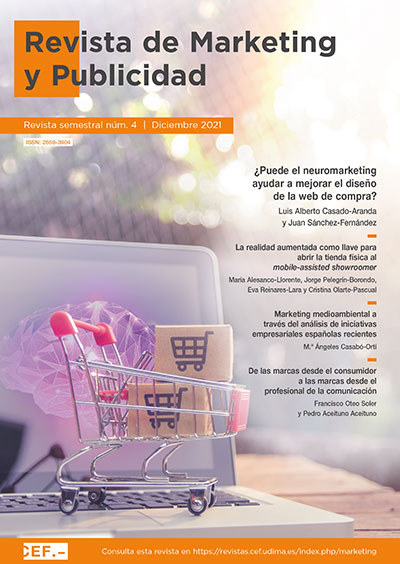Can neuromarketing help improve website layout? A neuroscientific study on hedonic and utilitarian shopping environments
DOI:
https://doi.org/10.51302/marketing.2021.800Keywords:
consumer neuroscience, web environment, hedonic, utilitarian, consumer behaviorAbstract
Previous research in the e-commerce field has defined the two most widely used web environments, namely the hedonic (visually appealing environment, focused on the hedonic (focused and interactive) and utilitarian (informative and functional). Yet, there are no unanimous conclusions on the influence of these typologies on consumer recall. Moreover, no study has evaluated the psychological mechanisms underlying the processing of hedonic and utilitarian websites, which could be crucial, given the unconscious and introspective origin of online purchase decisions. The current reasearch uses neuroimaging (functional magnetic resonance imaging, fMRI) for the first time to identify neural differences between hedonic and utilitarian website recall. The neural data shed light on the origin of enhanced recall for hedonic environments and confirm that, while hedonic designs activate brain areas related to emotion, memory encoding and working memory, utilitarian websites only elicit brain networks related to working memory and memory function. Taken together, these results provide crucial information about the connection of neuropsychological data to online consumer behavior, and may help in the design of efficient web environments for potential consumers.
Downloads
References
Baltas, G., Kokkinaki, F. y Loukopoulou, A. (2017). Does variety seeking vary between hedonic and utilitarian products? The role of attribute type. Journal of Consumer Behaviour, 16(6), e1- e12. https://doi.org/10.1002/cb.1649
Bilgihan, A. y Bujisic, M. (2015). The effect of website features in online relationship marketing: A case of online hotel booking. Electronic Commerce Research and Applications, 14(4), 222-232. https://doi.org/10.1016/j.elerap.2014.09.001
Borghesani, V., Narvid, J., Battistella, G., Shwe, W., Watson, C., Binney, R. J., Sturm, V., Miller, Z., Mandelli, M. L., Miller, B. y Gorno-Tempini, M. L. (2019). “Looks familiar, but I do not know who she is”: The role of the anterior right temporal lobe in famous face recognition. Cortex, 115, 72-85. https://doi.org/10.1016/j.cortex.2019.01.006
Casado-Aranda, L.-A., Dimoka, A. y Sánchez-Fernández, J. (2019). Consumer Processing of Online Trust Signals: A Neuroimaging Study. Journal of Interactive Marketing, 47, 159-180. https://doi.org/10.1016/j.intmar.2019.02.006
Casado-Aranda, L.-A., Sánchez-Fernández, J. y Montoro-Ríos, F. J. (2018). How Consumers Process Online Privacy, Financial, and Performance Risks: An fMRI Study. CyberPsychology, Behavior & Social Networking, 21(9), 556-562. Business Source Complete. https://doi.org/10.1089/cyber.2018.0196
Couwenberg, L. E., Boksem, M. A. S., Dietvorst, R. C., Worm, L., Verbeke, W. J. M. I. y Smidts, A. (2017). Neural responses to functional and experiential ad appeals: Explaining ad effectiveness. International Journal of Research in Marketing, 34(2), 355-366. https://doi.org/10.1016/j.ijresmar.2016.10.005
Dimoka, A. (2010). What does the brain tell us about trust and distrust? Evidence from a functional neuroimaging study. Mis Quarterly, 2(34), 373-396.
eMarketer. (2021). Global ecommerce update 2021. https://www.emarketer.com/content/global-ecommerce-update-2021
Falk, E. B., Rameson, L., Berkman, E. T., Liao, B., Kang, Y., Inagaki, T. K. y Lieberman, M. D. (2010). The neural correlates of persuasion: A common network across cultures and media. Journal of Cognitive Neuroscience, 22(11), 2.447-2.459.
Goodman, A. M., Wang, Y., Kwon, W.-S., Byun, S.-E., Katz, J. S. y Deshpande, G. (2017). Neural correlates of consumer buying motivations: A 7T functional magnetic resonance imaging (fMRI) study. Frontiers in Neuroscience, 11. https://doi.org/10.3389/fnins.2017.00512
Guerrero Medina, C. A., Martínez-Fiestas, M., Casado Aranda, L. A. y Sánchez-Fernández, J. (2021). Is it an error to communicate CSR Strategies? Neural differences among consumers when processing CSR messages. Journal of Business Research, 126, 99-112. https://doi.org/10.1016/j.jbusres.2020.12.044
Hausman, A. V. y Siekpe, J. S. (2009). The effect of web interface features on consumer online purchase intentions. Journal of Business Research, 62(1), 5-13. https://doi.org/10.1016/j.jbusres.2008.01.018
Hubert, M., Hubert, M., Linzmajer, M., Riedl, R., Kenning, P. y& Hubert, M. (2018). Trust me if you can – neurophysiological insights on the influence of consumer impulsiveness on trustworthiness evaluations in online settings. European Journal of Marketing, 52(1/2), 118-146. https://doi.org/10.1108/EJM-12-2016-0870
Jai, T.-M. (Catherine), Fang, D., Bao, F. S., James, R. N., Chen, T. y Cai, W. (2021). Seeing It Is Like Touching It: Unraveling the Effective Product Presentations on Online Apparel Purchase Decisions and Brain Activity (An fMRI Study). Journal of Interactive Marketing, 53, 66-79. https://doi.org/10.1016/j.intmar.2020.04.005
Johnson, E. L., Adams, J. N., Solbakk, A.-K., Endestad, T., Larsson, P. G., Ivanovic, J., Meling, T. R., Lin, J. J. y Knight, R. T. (2018). Dynamic frontotemporal systems process space and time in working memory. PLOS Biology, 16(3), e2004274. https://doi.org/10.1371/journal.pbio.2004274
Li, J., Abbasi, A., Cheema, A. y Abraham, L. B. (2020). Path to Purpose? How Online Customer Journeys Differ for Hedonic Versus Utilitarian Purchases. Journal of Marketing, 84(4), 127-146. https://doi.org/10.1177/0022242920911628
Liang, T.-P. y Lai, H.-J. (2002). Effect of store design on consumer purchases: An empirical study of on-line bookstores. Information & Management, 39(6), 431-444. https://doi.org/10.1016/S0378-7206(01)00129-X
Mazaheri, E., Richard, M. y Laroche, M. (2012). The role of emotions in online consumer behavior: A comparison of search, experience, and credence services. Journal of Services Marketing, 26(7), 535-550. https://doi.org/10.1108/08876041211266503
Moon, M. A., Khalid, M. J., Awan, H. M., Attiq. S., Rasool, H. y Kiran, M. (2017). Consumer’s perceptions of website’s utilitarian and hedonic attributes and online purchase intentions: A cognitive-affective attitude approach. Spanish Journal of Marketing - ESIC, 21(2), 73-88. https://doi.org/10.1016/j.sjme.2017.07.001
Motoki, K., Suzuki, S., Kawashima, R. y Sugiura, M. (2020). A Combination of self-reported data and social-related neural measures forecasts viral marketing success on social media. Journal of Interactive Marketing, 52, 99-117. https://doi.org/10.1016/j.intmar.2020.06.003
Panda, T. K., Panda, T. K. y Mishra, K. (2013). Does emotional appeal work in advertising? The rationality behind using emotional appeal to create favorable brand attitude. IUP Journal of Brand Management, 10(2), 7.
Rose, S., Hair, N. y Clark, M. (2011). Online customer experience: A review of the business- to-consumer online purchase context: online customer experience. International Journal of Management Reviews, 13(1), 24-39. https://doi.org/10.1111/j.1468-2370.2010.00280.x
Rosen, D. E. y Purinton, E. (2004). Website design: Viewing the web as a cognitive landscape. Journal of Business Research, 57(7), 787-794. https://doi.org/10.1016/S0148-2963(02)00353-3
Schaefer, M. y Rotte, M. (2007). Thinking on luxury or pragmatic brand products: Brain responses to different categories of culturally based brands. Brain Research, 1165, 98-104. https://doi.org/10.1016/j.brainres.2007.06.038
Statista. (2021). Global digital buyer reach 2021. https://www.statista.com/statistics/261676/digital-buyer-penetration-worldwide/
Tsukiura, T. y Cabeza, R. (2011). Remembering beauty: Roles of orbitofrontal and hippocampal regions in successful memory encoding of attractive faces. NeuroImage, 54(1), 653-660. https://doi.org/10.1016/j.neuroimage.2010.07.046
Yarkoni, T., Poldrack, R. A., Nichols, T. E., Van Essen, D. C. y Wager, T. D. (2011). Large-scale automated synthesis of human functional neuroimaging data. Nature Methods, 8(8), 665-670. https://doi.org/10.1038/nmeth.1635
Downloads
Published
How to Cite
Issue
Section
License
Copyright (c) 2022 Luis-Alberto Casado-Aranda , Juan Sánchez-Fernández

This work is licensed under a Creative Commons Attribution-NonCommercial-NoDerivatives 4.0 International License.





















